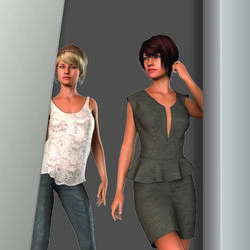Spanish SME aims for top spot in virtual fitting room market
With eCommerce sales set to increase by 18.4 % this year, this market can hardly be ignored by clothing retailers. But is the investment worth the risk? In Europe, only 7 % of online purchases are attributed to the fashion market, and the sector unwillingly shines with the highest return rate in eCommerce — reaching a head-spinning 40 % of all clothes sold online. ‘Bad fit is the cause of return in approximately 75 % of sales, being mostly due to confusing garment sizing and label systems, as well as the low reliability of advising methods to help customers choose the proper sizing,’ says Ana M. Bernardeau, CEO at Visualook. ‘When deciding whether to buy or not, the customer relies on the possibility of getting a realistic overview of the look and fit of the garment. E-buyers tend not to trust the online experience, and those who do try, often end up being frustrated.’ Numerous companies have entered a race to resolve this long-standing issue while getting their hands on a potentially huge market. Most of these solutions are still under development, while others have dismally failed to capture the industry’s attention, but the one developed by Tecnologías DIM’s high-tech start-up Visualook could actually be a real game changer. Compared to alternatives plagued by the size recommendation’s poor reliability and the preview tool’s lack of realism, the system promises to recommend the proper size selection and to accurately represent the user as he/she wears a selection of garments from an e-shop catalogue. All this is made possible thanks to an algorithm which combines key anthropometric measurements with the different sizing guide of each manufacturer. ‘Contrary to other initiatives which rely on generic avatars or avatars generated from 2D pictures or adapted from tape auto-measures to provide garment visualisation to the customer, Tecnologías DIM managed to capture and represent the 3D geometry of the user. This is what we call the “personal avatar”,’ Bernardeau says enthusiastically. The system, which is available via a smartphone application, boasts a 90 % success rate in recreating the body dimensions of the customer, along with the possibility of combining up to four garments. It is also very easy to get up and running: Visualook provides a link to the retailer which points to an address hosted on their server, then it’s all set up and ready to go. Going global The European Commission, which strongly believes in the technology’s potential, granted Tecnologías DIM funding under Phase 1 of the SME Instrument for the VISUALOOK (Novel clothing e-commerce application for reliable size assignment and realistic fitting visualization) project. This enabled the company to test the technical and economic viability of its products and assess the potential return on investment for customers. The results are so positive that Bernardeau and his team have already applied for Phase 2. ‘During the development of Phase I, we have carried out three pilot tests with retailer brands which have already used the initial beta version of the web-based virtual “try on and calculate your size” software. This has helped us to have more detailed information about rates than what we had when we presented the proposal: We estimate the benefits to be around 25 % in sales increases and 30 % in reduced returns, and these figures are still expected to grow when we complete the development.’ Bernardeau says users and fashion retailers were equally pleased with the experience and he is now thinking about the next steps: securing a leading position in the sector; rapidly increasing the market share and sales of the company; and becoming a reference in clothing e-commerce. ‘To do that, we need the help of the SME Instrument. We need to optimise the 3D modelling process of virtual clothing — including mobile body capture — and to launch a pilot test in an operational environment with retailers, so that we can validate not only the technology but also the business figures,’ she concludes. ‘Visualook will first target online fashion manufacturers and retailers in Spain and Italy, followed by other European countries and probably South American ones such as Chile in 2017, as we already have some very good contacts there. In Europe alone, the online apparel retail market represents around EUR 40 billion with annual growth of 20 %.’
Keywords
Smart textiles, safety shoes, biometric sensors







